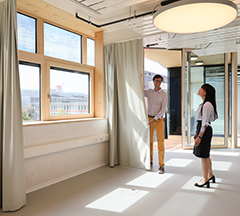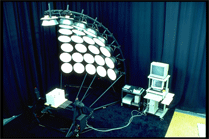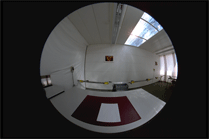Group leader: Prof. J.-L. Scartezzini (associate editor for Daylighting in Solar Energy Journal)
PhD students: Yujie Wu, Marta Benedetti

Ample and judicious use of daylight in buildings has a positive impact not only on electricity consumption but also on occupants’ health and productivity.
To strike a balance between energy savings and user comfort, daylight research in our lab currently focuses on integrated day and electric lighting control as well as on innovative glazing technologies.
Earlier research conducted in this field produced a sophisticated daylighting laboratory with, among other, a scanning sky simulator and an automated heliodon, which allow reproducing with very high precision all daylight conditions that exist around the world. Several anidolic (non-imaging) daylight transmission systems were developed and tested. A bidirectional reflection and transmission photogoniometer was developed to test the characteristics of advanced glazing.
Research related to visual and non-visual aspects of light on human physiology and behavior was carried out under the supervision of Dr Mirjam Münch, who set up a photobiological laboratory with different light sources for this purpose. Her work was funded by Velux Foundation.
Finally, software tools have been developed to help architects and planners understand the impact of their designs.


Published work relates to
- HDR vision sensing technology for automatic shading and lighting control systems
- Integrated multifunctional glazing for dynamic daylighting
- Self-sufficient lighting systems
- Impact of light on humans, in particular circadian aspects of (day-)light on human physiology, behavior and visual comfort
- Anidolic Systems for non-imaging light transmission into darker building locations
- Scanning sky simulator and Heliodon for the reproduction of any daylight conditions
- Bidirectional reflection and transmission photogoniometer
- Daylighting and ergonomical test chambers
- Measuring methods and devices
- Daylighting tools
- Monochromatic light sources
- Green lighting – High performance integrated daylighting and electric lighting systems
- Comparing daylighting performance assessment of complex fenestration systems of buildings
- Circadian aspects of (day-)light on human physiology, behavior and visual comfort
- High-resolution mapping of the sky and ground dome
PhD theses published in this domain:
- Integrated Daylighting and Artificial Lighting Control based on High Dynamic Range Vision Sensors. Thèse EPFL, Ali Motamed, 2017
- “On advanced daylighting simulations and integrated performance assessment of complex fenestration systems for sunny climates”, Chantal Basurto, 2015
- “The Impact of Light Including Non-Image Forming Effects on Visual Comfort“, Apiparn Borisuit, 2013
- “Optimisation of Urban Form by the Evaluation of the Solar Potential“, Marylène Montavon, 2010
- “Energetic, Visual and Non-visual Aspects of Office Lighting“, Friedrich Linhart, 2009
- “Comparing physical and virtual methods for daylight performance modelling including complex fenestration systems“, Anothaï Thanachareonkit, 2008
- “Bayesian optimisation of visual comfort “, David Lindelof, 2007
- “Innovative Bidirectional Video-Goniophotometer for Advanced Fenestration Systems “, Maryline Andersen, 2004 (Prix Chorafas 2005)
- “Méthode expérimentale d’évaluation des performances lumineuses de bâtiments“, Laurent Michel, 1999
- “Systèmes anidoliques d’éclairage naturel“, Gilles Courret, 1999
- “Application de la logique floue à l’aide à la décision en éclairage naturel“, Bernard Paule, 1999
- “Simulations numériques de systèmes d’éclairage naturel à pénétration latérale“, Raphaël Compagnon, 1993
Tools:
- Geronimo – Software for the visualisation of the impact of Complex Fenestration Systems (CFS)
- Daylighting Handbook
- LESO-DIAL, DIAL-Europe Daylighting Design Tools
- Radiance Synthetic imaging system – Unix freeware for lighting design and rendering
- Adeline Integrated lighting design computer tool